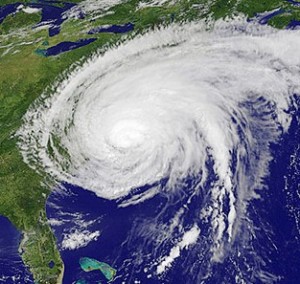This Industry Viewpoint was authored by Alan Creighton, the President and CEO of Momentum Telecom. You can find more of his writings on the Go Momentum Blog blog.
Hurricane Sandy brought substantial destruction to homes and businesses across the Northeastern region of the country just about a month ago today. In the aftermath, telecommunications service providers reported outages that left 25% of the cell towers in 10 states without power and as many as 8 million customers without the ability to communicate with colleagues and clients – some for weeks, according to an FCC estimate.
 Though we are unable to prevent natural catastrophes, Hurricane Sandy reminds us of the importance of taking measures to be ready. Preparing contact centers for disaster is no exception. As the president & CEO of a telecommunications provider, I understand my responsibility to take as many preemptive measures as possible to ensure continued functionality of my company’s network – especially during crisis.
Though we are unable to prevent natural catastrophes, Hurricane Sandy reminds us of the importance of taking measures to be ready. Preparing contact centers for disaster is no exception. As the president & CEO of a telecommunications provider, I understand my responsibility to take as many preemptive measures as possible to ensure continued functionality of my company’s network – especially during crisis.
Over the past weeks, I have continued to track the aftermath of the storm and have been reminded of the impact that natural disasters, like Sandy, can have on businesses. Times like these emphasize the importance of disaster preparation.
A business’ lifeline is its communications. Organizations that aren’t prepared for disasters and lose communication capabilities risk sales opportunities, revenue and even valuable clients. Every enterprise should take the time to ensure that it has a disaster recovery plan in place, and that its provider is prepared to keep communications up and running. Here are three key factors to consider about your business communications before catastrophe strikes:
The Location of the Cloud. Though its services are virtual, the cloud is tied to a physical location along with the information stored there. As we saw after Hurricane Sandy, flooding knocked out several carriers’ switches in New York and New Jersey and left thousands of business lines down across the country. Businesses can avoid a breakdown in communications by simply choosing a provider that has a geographically dispersed network infrastructure with switches in more than one location. Geo-redundancy insulates businesses from having to experience the effects of a core network crash and prevents disruption in business communications. In the event of a switch outage, another location can serve as backup and preserve uptime.
The Core Network Infrastructure. Providers that rely on Time-Division Multiplexing (TDM) trunks for communication set businesses up for trouble in the wake of a disaster. TDM trunks are physically tied to a local switch, so when flooding like we saw during Hurricane Sandy knocks out the circuit, businesses can’t access their communications. TDM trunks become a single point of failure because numbers tied to a TDM trunk are unable to easily move to another switch. Hosted VoIP providers use the power of IP circuits or the Internet to deliver voice services and run with IP-based core network infrastructures that allow for numbers to be instantly moved to a backup switch to process calls and maintain network uptime.
The Point of Access. By choosing cloud-based VoIP services, businesses can ensure that employees are able to continue business correspondence and access communications in a number of different ways. When a circuit goes down, users with Hosted VoIP can reach their business line with a unified communications application by enabling a Wi-Fi hotspot or using a cellular voice or data network. If you can access any form of wireline or wireless network, you can get to your business communications with inbound and outbound business identity dialing. Features like Unreachable Destination can also ensure businesses can continue to communicate even when the IP access circuit is out of operation by enabling users to set an alternate phone number to which calls can be routed.
Businesses without these services found themselves without a way to communicate during the outages that followed the hurricane. VoIP technology is mature, and the features and benefits clearly outweigh TDM. Put your business communications in the cloud with geo-redundancy so that if disaster strikes, your business is prepared.
If you haven't already, please take our Reader Survey! Just 3 questions to help us better understand who is reading Telecom Ramblings so we can serve you better!
Categories: Fiber Networks · Industry Viewpoint · Unified Communications · VoIP





This is excellent advice for all companies. We take for granted all of the many technical advances we use every day. Communication is key for surviving a natural disaster. Each company should also encourage employees to have some kind of survival gear at work for their employees.
You’re right, I think the biggest lesson we have learned from Hurricane Sandy is to always be prepared. This means taking preemptive measures and having a disaster recovery plan in place. The good news is that Hurricane Sandy did prove just how resilient the Internet truly is, with the majority of the storm’s impact remaining local.